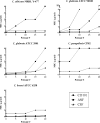Characterization of In Vitro Resistance Development to the Novel Echinocandin CD101 in Candida Species
- PMID: 27480852
- PMCID: PMC5038289
- DOI: 10.1128/AAC.00620-16
Characterization of In Vitro Resistance Development to the Novel Echinocandin CD101 in Candida Species
Abstract
CD101 is a novel echinocandin with a long half-life undergoing clinical development for treatment of candidemia/invasive candidiasis and vulvovaginal candidiasis. The potential for and mechanisms underlying the development of resistance to CD101 in Candida species were investigated by using spontaneous resistance and serial passage selection methodologies. Four Candida spp. (C. albicans, C. glabrata, C. parapsilosis, and C. krusei) were chosen for resistance characterization with CD101, anidulafungin, and caspofungin. The frequency of spontaneous, single-step mutations conferring reduced susceptibility to CD101 at 1× the agar growth inhibition concentration was low across all species, with median frequencies ranging from 1.35 × 10(-8) to 3.86 × 10(-9), similar to ranges generated for anidulafungin and caspofungin. Serial passage of Candida spp. on agar plates containing drug gradients demonstrated a low potential for resistance development, with passage 20 CD101-selected strains possessing increases in MICs equivalent to or lower than those for the majority of strains generated under selection with anidulafungin and caspofungin. A total of 12 fks "hot spot" mutations were identified, typically in strains with the highest MIC shifts. Cross-resistance was broadly observed among the 3 echinocandins evaluated, with no CD101-selected mutants (with or without fks hot spot mutations) exhibiting reduced susceptibility to CD101 but not also to anidulafungin and/or caspofungin. Consistent with currently approved echinocandins, CD101 demonstrates a low potential for resistance development, which could be further enhanced in vivo by the high maximum concentration of drug in serum (Cmax)/area under the concentration-time curve (AUC) plasma drug exposure achieved with once-weekly dosing of CD101.
Copyright © 2016 Locke et al.
Figures
Similar articles
-
Spontaneous Mutational Frequency and FKS Mutation Rates Vary by Echinocandin Agent against Candida glabrata.Antimicrob Agents Chemother. 2018 Dec 21;63(1):e01692-18. doi: 10.1128/AAC.01692-18. Print 2019 Jan. Antimicrob Agents Chemother. 2018. PMID: 30373796 Free PMC article.
-
Activity of a long-acting echinocandin, CD101, determined using CLSI and EUCAST reference methods, against Candida and Aspergillus spp., including echinocandin- and azole-resistant isolates.J Antimicrob Chemother. 2016 Oct;71(10):2868-73. doi: 10.1093/jac/dkw214. Epub 2016 Jun 10. J Antimicrob Chemother. 2016. PMID: 27287236 Free PMC article.
-
In vitro activity of the novel echinocandin CD101 at pH 7 and 4 against Candida spp. isolates from patients with vulvovaginal candidiasis.J Antimicrob Chemother. 2017 May 1;72(5):1355-1358. doi: 10.1093/jac/dkx008. J Antimicrob Chemother. 2017. PMID: 28158577 Free PMC article.
-
Candida and candidaemia. Susceptibility and epidemiology.Dan Med J. 2013 Nov;60(11):B4698. Dan Med J. 2013. PMID: 24192246 Review.
-
Clinical breakpoints for the echinocandins and Candida revisited: integration of molecular, clinical, and microbiological data to arrive at species-specific interpretive criteria.Drug Resist Updat. 2011 Jun;14(3):164-76. doi: 10.1016/j.drup.2011.01.004. Epub 2011 Feb 24. Drug Resist Updat. 2011. PMID: 21353623 Review.
Cited by
-
Rezafungin In Vitro Activity against Contemporary Nordic Clinical Candida Isolates and Candida auris Determined by the EUCAST Reference Method.Antimicrob Agents Chemother. 2020 Mar 24;64(4):e02438-19. doi: 10.1128/AAC.02438-19. Print 2020 Mar 24. Antimicrob Agents Chemother. 2020. PMID: 32015032 Free PMC article.
-
Activity of a Long-Acting Echinocandin, Rezafungin, and Comparator Antifungal Agents Tested against Contemporary Invasive Fungal Isolates (SENTRY Program, 2016 to 2018).Antimicrob Agents Chemother. 2020 Mar 24;64(4):e00099-20. doi: 10.1128/AAC.00099-20. Print 2020 Mar 24. Antimicrob Agents Chemother. 2020. PMID: 32015043 Free PMC article.
-
Rezafungin versus caspofungin for patients with candidaemia or invasive candidiasis in the intensive care unit: pooled analyses of the ReSTORE and STRIVE randomised trials.Crit Care. 2024 Oct 28;28(1):348. doi: 10.1186/s13054-024-05117-5. Crit Care. 2024. PMID: 39468640 Free PMC article. Clinical Trial.
-
Antifungal resistance: current trends and future strategies to combat.Infect Drug Resist. 2017 Aug 29;10:249-259. doi: 10.2147/IDR.S124918. eCollection 2017. Infect Drug Resist. 2017. PMID: 28919789 Free PMC article. Review.
-
Echinocandins Susceptibility Patterns of 2,787 Yeast Isolates: Importance of the Thresholds for the Detection of FKS Mutations.Antimicrob Agents Chemother. 2022 May 17;66(5):e0172521. doi: 10.1128/aac.01725-21. Epub 2022 Apr 12. Antimicrob Agents Chemother. 2022. PMID: 35412354 Free PMC article.
References
-
- Shields RK, Nguyen MH, Press EG, Kwa AL, Cheng S, Du C, Clancy CJ. 2012. The presence of an FKS mutation rather than MIC is an independent risk factor for failure of echinocandin therapy among patients with invasive candidiasis due to Candida glabrata. Antimicrob Agents Chemother 56:4862–4869. doi:10.1128/AAC.00027-12. - DOI - PMC - PubMed
-
- Katiyar SK, Alastruey-Izquierdo A, Healey KR, Johnson ME, Perlin DS, Edlind TD. 2012. Fks1 and Fks2 are functionally redundant but differentially regulated in Candida glabrata: implications for echinocandin resistance. Antimicrob Agents Chemother 56:6304–6309. doi:10.1128/AAC.00813-12. - DOI - PMC - PubMed
-
- Alexander BD, Johnson MD, Pfeiffer CD, Jimenez-Ortigosa C, Catania J, Booker R, Castanheira M, Messer SA, Perlin DS, Pfaller MA. 2013. Increasing echinocandin resistance in Candida glabrata: clinical failure correlates with presence of FKS mutations and elevated minimum inhibitory concentrations. Clin Infect Dis 56:1724–1732. doi:10.1093/cid/cit136. - DOI - PMC - PubMed
-
- Healey KR, Zhao Y, Perez WB, Lockhart SR, Sobel JD, Farmakiotis D, Kontoyiannis DP, Sanglard D, Taj-Aldeen SJ, Alexander BD, Jiminez-Ortigosa C, Shor E, Perlin DS. 2016. Prevalent mutator genotype identified in fungal pathogen Candida glabrata promotes multi-drug resistance. Nat Commun 7:11128. doi:10.1038/ncomms11128. - DOI - PMC - PubMed
MeSH terms
Substances
LinkOut - more resources
Full Text Sources
Other Literature Sources
Miscellaneous


